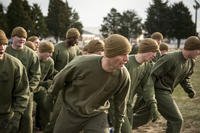The importance of strength in tactical professions cannot be overstated. Strength is the foundation of our durability and longevity. While fitness requirements may vary across different military roles, the need for strength remains constant and grows more crucial each year. Incorporating resistance training into your routine can help maintain body composition and fortify bones, joints and muscles while enhancing stability.
If you're considering adding weightlifting to your regimen, the 5x5 is a classic strength-building set-rep system, and it could be valuable to you. I have been using and teaching this system for more than 25 years. You can choose many lifts and these workouts are usually shorter than typical calisthenics and cardio workouts, which use high reps and high miles for muscle stamina and endurance. For our Seasonal Tactical Fitness Periodization system, these types of lifts fit perfectly into our fall and winter seasons.
While it is essential to be strong, it is also important not to neglect the other elements of fitness, especially while performing tactical training. The goal is that it leaves no element of fitness undeveloped. Strength, power, speed, agility, muscle stamina, endurance (run, ruck, swim), flexibility, mobility and grip help to build a well-rounded tactical athlete. The 5x5 has significantly reduced training injuries, improved performance in tactical programs by reducing weaknesses and added variety to training, which allows people to stay more engaged throughout the year.
Many strength coaches and programs recommend and utilize the 5x5 workout as part of the strength training journey. Strong Lifts and Starting Strength are excellent programs to learn how to add 5x5 to your training life correctly. The classic five lifts used in this program are the following:
• Bench press
• Back squat
• Deadlift
• Overhead press
• Barbell Row
One of the great things about the 5x5 system is its flexibility. While most people start with the Big Three (bench press, back squat and deadlift), you can include other exercises that suit your fitness goals and preferences. Whether it's weighted calisthenics, pull-ups or dips, you have the freedom to customize your workout.
The key is to select a weight that challenges you for five reps and gradually increase the weight as you progress. Many will pick a weight that is 75%-80% of their one-rep max. If you do not know that weight, just spend some time in the gym figuring out the weight that you can barely do five times.
How to Add the 5x5 to Your Training Week
Planning your training week with the 5x5 system is straightforward. The first recommendation is to do it every other day, especially if you repeat the same lifts. Most people who program this 5x5 will do the same lift repeats on Day 1 and Day 5 (Monday and Friday). This offers the most recovery between heavy lifts. You may need more recovery between lifting days, as getting stronger requires the entire body and central nervous system to work harder than normal calisthenics and cardio workouts.
This could mean doing a few lifts twice weekly and a few once weekly, then flipping the lifts the following week. This system works well for different schedules, no matter your preference. The key is to find a rhythm that works for you and stick to it.
Another option is to mix in a push-pull-leg split routine, doing the bench press or overhead press on one day, then deadlifts and rows the next, with squats on the third day to complete the exercise cycle.
You could do the push-pull-leg split routine again in the week but change the push day to the lift you did not do if you want to use these five lifting options in your 5x5 lifting cycle. The push-pull-leg split also fits well with the Big Three, respectively.
Doing them just once or trying a second cycle in the week is your choice, and it should be a more advanced lift, focused on recovery, to try the Big Three twice each week. Finding auxiliary lifts and/or calisthenics to add to these push-pull-leg cycles is up to you. After the lifts, you can mix in some machine lifts, dumbbell exercises and even cardio (easy-paced or sprints for speed).
You may see big gains when you start, but progressively adding weight will be important after the first month. If you do not progress regularly, consider taking a few rest days, longer rest periods between lifts, and focusing more on your sleep and nutrition. The strength workout only works if you push yourself with it and actively pursue your own recovery.
Stew Smith is a former Navy SEAL and fitness author certified as a Strength and Conditioning Specialist (CSCS) with the National Strength and Conditioning Association. Visit his Fitness eBook store if you're looking to start a workout program to create a healthy lifestyle. Send your fitness questions to stew@stewsmith.com
Want to Learn More About Military Life?
Whether you're thinking of joining the military, looking for fitness and basic training tips, or keeping up with military life and benefits, Military.com has you covered. Subscribe to Military.com to have military news, updates and resources delivered directly to your inbox.


















